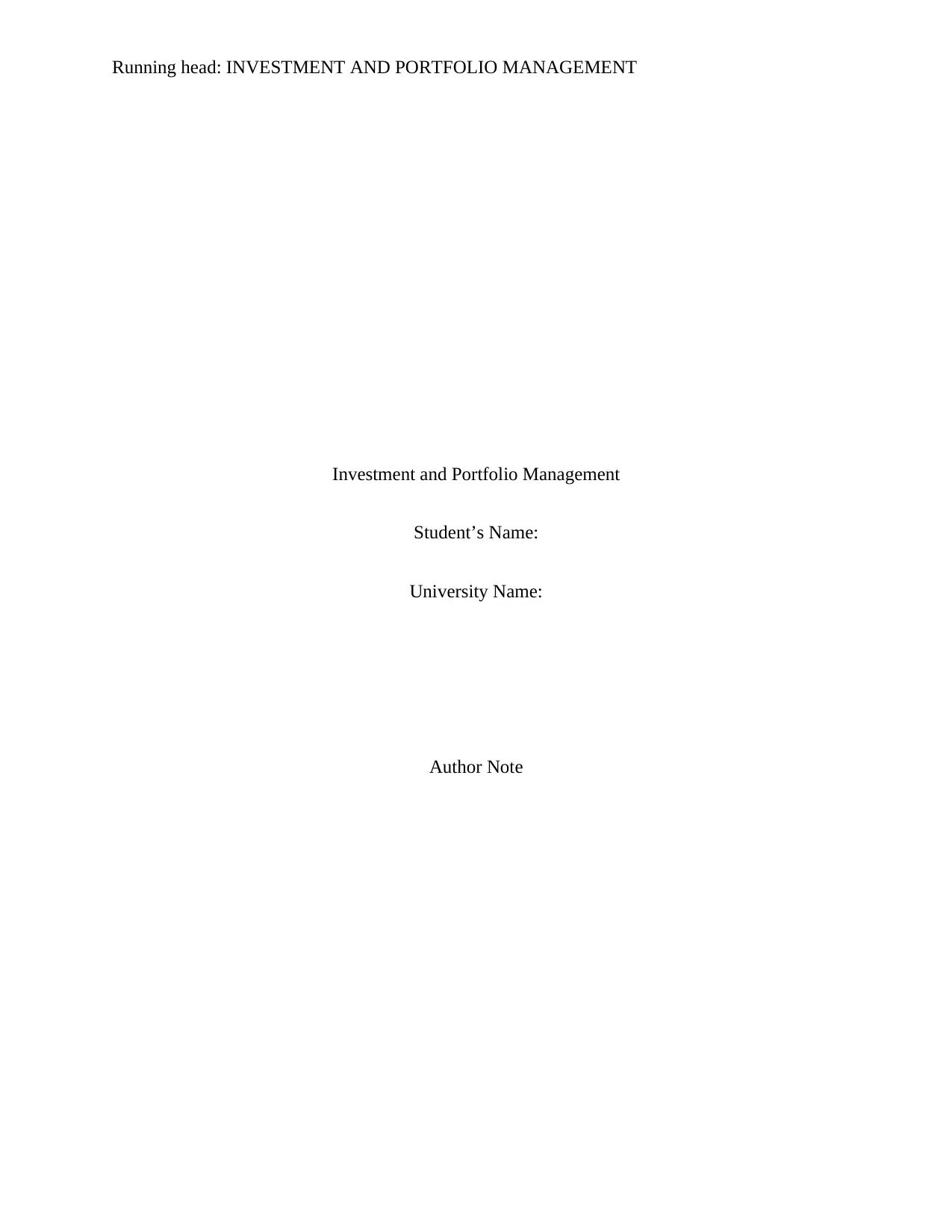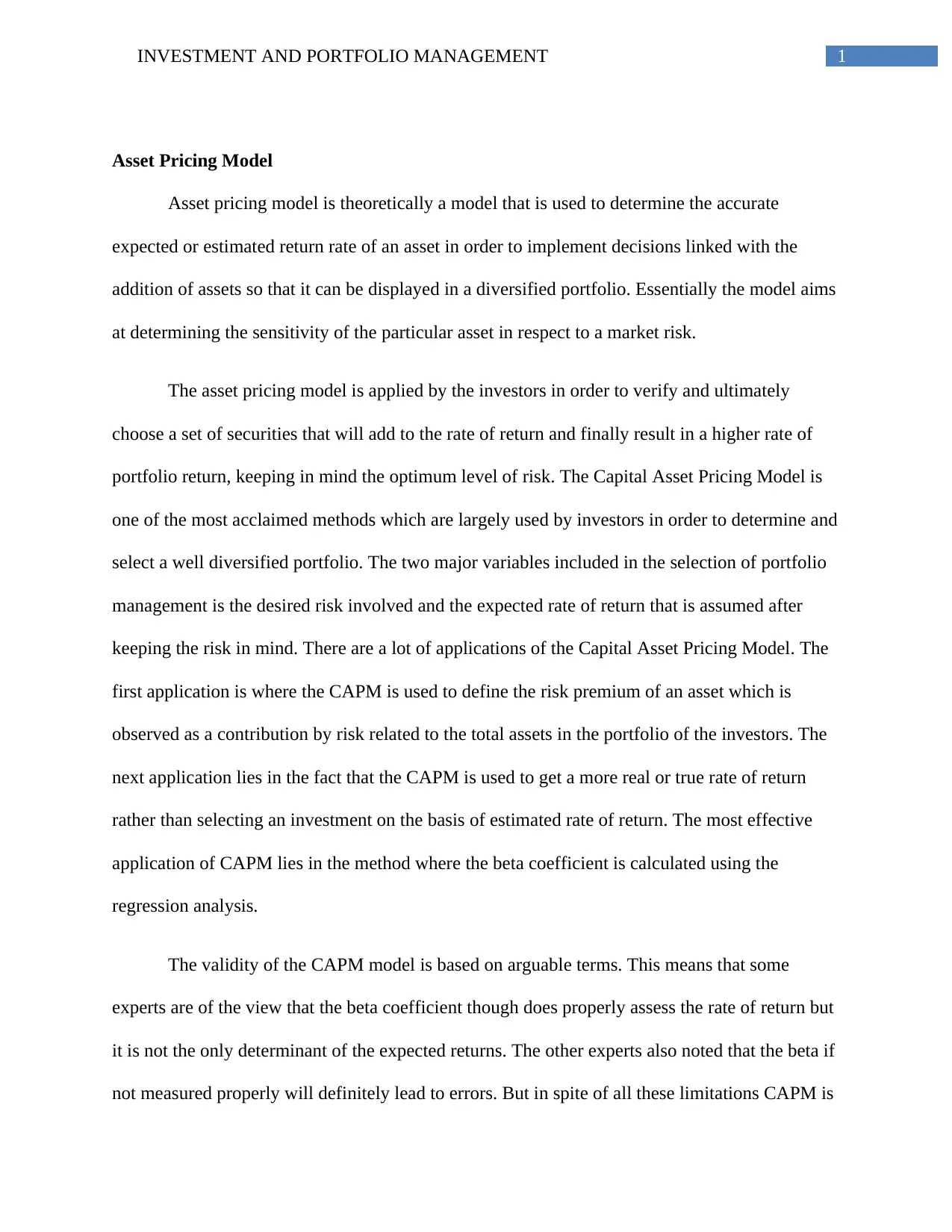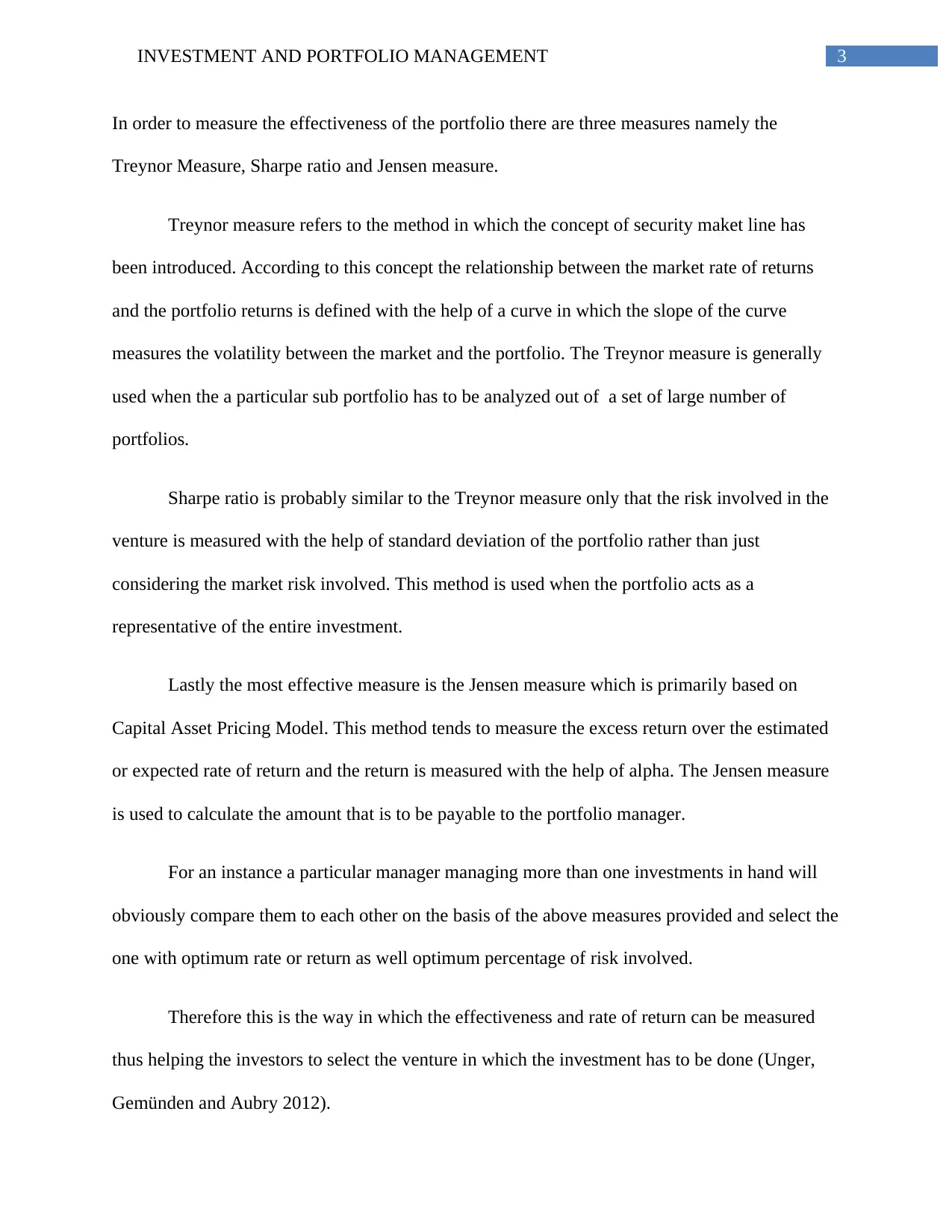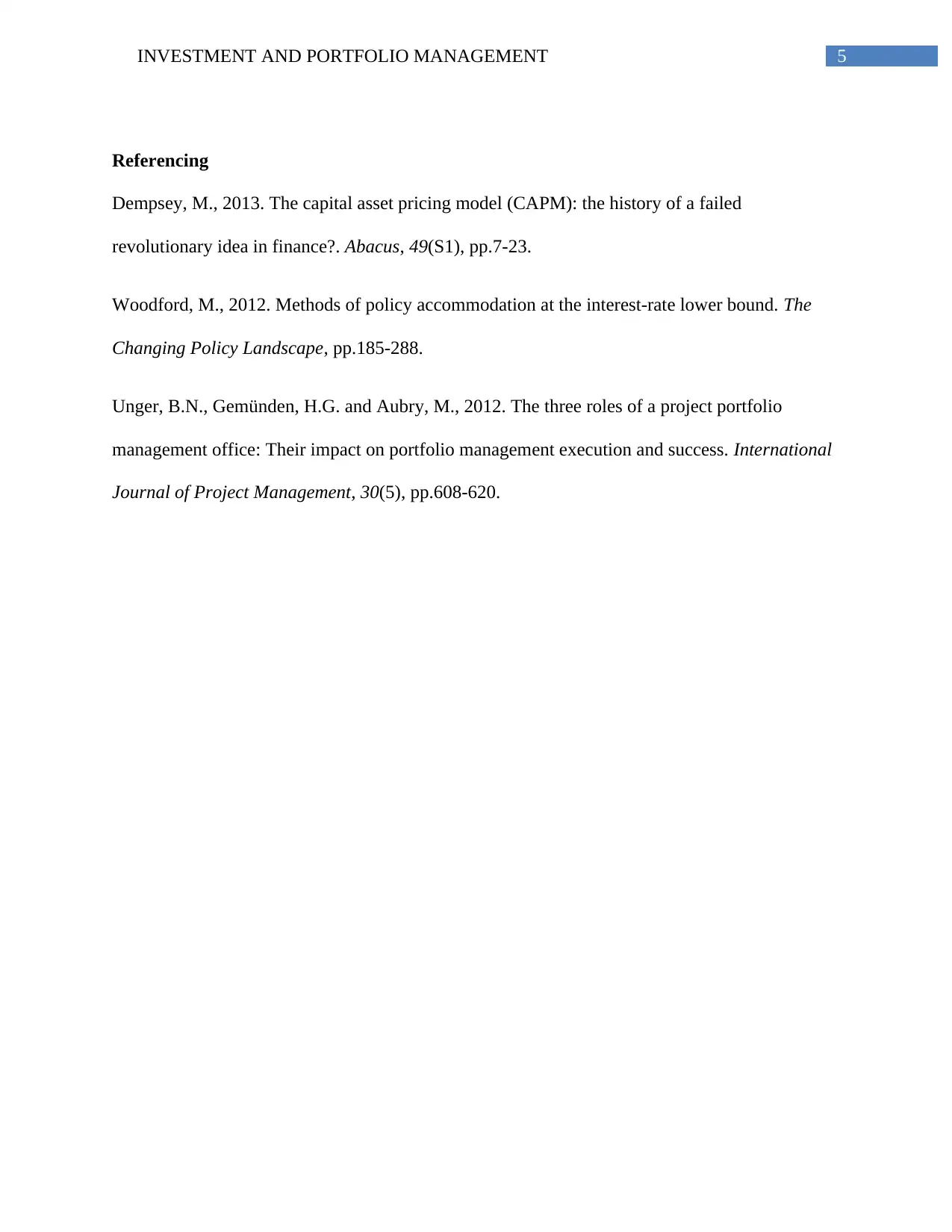Investment and Portfolio Management: A Comprehensive Overview Report
VerifiedAdded on 2020/05/11
|7
|1104
|60
Report
AI Summary
This report delves into key concepts in investment and portfolio management. It begins with an explanation of asset pricing models, with a focus on the Capital Asset Pricing Model (CAPM) and its applications in determining asset risk premiums and expected returns. The report then examines bonds, discussing their sensitivity to interest rate changes and the associated risks, such as credit risk and interest rate fluctuation. Finally, it explores portfolio performance evaluation, introducing and comparing the Treynor measure, Sharpe ratio, and Jensen measure as tools for assessing and comparing investment strategies, and the significance of these tools for investors and portfolio managers. The report emphasizes the importance of considering both risk and return in investment decisions.

Running head: INVESTMENT AND PORTFOLIO MANAGEMENT
Investment and Portfolio Management
Student’s Name:
University Name:
Author Note
Investment and Portfolio Management
Student’s Name:
University Name:
Author Note
Paraphrase This Document
Need a fresh take? Get an instant paraphrase of this document with our AI Paraphraser

1INVESTMENT AND PORTFOLIO MANAGEMENT
Asset Pricing Model
Asset pricing model is theoretically a model that is used to determine the accurate
expected or estimated return rate of an asset in order to implement decisions linked with the
addition of assets so that it can be displayed in a diversified portfolio. Essentially the model aims
at determining the sensitivity of the particular asset in respect to a market risk.
The asset pricing model is applied by the investors in order to verify and ultimately
choose a set of securities that will add to the rate of return and finally result in a higher rate of
portfolio return, keeping in mind the optimum level of risk. The Capital Asset Pricing Model is
one of the most acclaimed methods which are largely used by investors in order to determine and
select a well diversified portfolio. The two major variables included in the selection of portfolio
management is the desired risk involved and the expected rate of return that is assumed after
keeping the risk in mind. There are a lot of applications of the Capital Asset Pricing Model. The
first application is where the CAPM is used to define the risk premium of an asset which is
observed as a contribution by risk related to the total assets in the portfolio of the investors. The
next application lies in the fact that the CAPM is used to get a more real or true rate of return
rather than selecting an investment on the basis of estimated rate of return. The most effective
application of CAPM lies in the method where the beta coefficient is calculated using the
regression analysis.
The validity of the CAPM model is based on arguable terms. This means that some
experts are of the view that the beta coefficient though does properly assess the rate of return but
it is not the only determinant of the expected returns. The other experts also noted that the beta if
not measured properly will definitely lead to errors. But in spite of all these limitations CAPM is
Asset Pricing Model
Asset pricing model is theoretically a model that is used to determine the accurate
expected or estimated return rate of an asset in order to implement decisions linked with the
addition of assets so that it can be displayed in a diversified portfolio. Essentially the model aims
at determining the sensitivity of the particular asset in respect to a market risk.
The asset pricing model is applied by the investors in order to verify and ultimately
choose a set of securities that will add to the rate of return and finally result in a higher rate of
portfolio return, keeping in mind the optimum level of risk. The Capital Asset Pricing Model is
one of the most acclaimed methods which are largely used by investors in order to determine and
select a well diversified portfolio. The two major variables included in the selection of portfolio
management is the desired risk involved and the expected rate of return that is assumed after
keeping the risk in mind. There are a lot of applications of the Capital Asset Pricing Model. The
first application is where the CAPM is used to define the risk premium of an asset which is
observed as a contribution by risk related to the total assets in the portfolio of the investors. The
next application lies in the fact that the CAPM is used to get a more real or true rate of return
rather than selecting an investment on the basis of estimated rate of return. The most effective
application of CAPM lies in the method where the beta coefficient is calculated using the
regression analysis.
The validity of the CAPM model is based on arguable terms. This means that some
experts are of the view that the beta coefficient though does properly assess the rate of return but
it is not the only determinant of the expected returns. The other experts also noted that the beta if
not measured properly will definitely lead to errors. But in spite of all these limitations CAPM is

2INVESTMENT AND PORTFOLIO MANAGEMENT
used worldwide by investors (Dempsey 2013). For instance when a choice is provided between
two investments, the one with the higher beta coefficient has to be selected.
Bonds -sensitivity to interest rate changes
Bonds are essentially financial statements that are used in order to obtain a continuous
inflow of cash payments in the form of interest at regular intervals. Risk related to the payment
of interests related to a bond is the factor that affects the price of bonds. Bonds are highly
sensitive to the change in interest rates. The yield or discount rate that is attached with a
particular bond when increases, the price of the bond decreases and when the yield decreases the
price increases. Thus when the interest rates fluctuate in the market, the yield or discount rates of
the bonds increase therefore the price of the bonds decrease. The fluctuations in short-term
interest rates will definitely affect different types of bonds with different maturity terms. In times
of inflation a particular firm may increase the yield of a particular bond in order to retain its
investors but in the process the price of the bond will surely decrease.
The weaknesses related to the bonds are the credit risk and fluctuation in the rate of
interest risk. The fluctuation in the rate of interest risk is the primary weakness as described
above and secondly the credit risk is the risk that is associated with risk of default. Therefore
these are the two weaknesses associated with bonds (Woodford 2012).
Portfolio performance
The performances of the portfolio of an investor depend not only upon the estimated rate
of return but also on the percentage of desired risk that is involved in the particular investment.
used worldwide by investors (Dempsey 2013). For instance when a choice is provided between
two investments, the one with the higher beta coefficient has to be selected.
Bonds -sensitivity to interest rate changes
Bonds are essentially financial statements that are used in order to obtain a continuous
inflow of cash payments in the form of interest at regular intervals. Risk related to the payment
of interests related to a bond is the factor that affects the price of bonds. Bonds are highly
sensitive to the change in interest rates. The yield or discount rate that is attached with a
particular bond when increases, the price of the bond decreases and when the yield decreases the
price increases. Thus when the interest rates fluctuate in the market, the yield or discount rates of
the bonds increase therefore the price of the bonds decrease. The fluctuations in short-term
interest rates will definitely affect different types of bonds with different maturity terms. In times
of inflation a particular firm may increase the yield of a particular bond in order to retain its
investors but in the process the price of the bond will surely decrease.
The weaknesses related to the bonds are the credit risk and fluctuation in the rate of
interest risk. The fluctuation in the rate of interest risk is the primary weakness as described
above and secondly the credit risk is the risk that is associated with risk of default. Therefore
these are the two weaknesses associated with bonds (Woodford 2012).
Portfolio performance
The performances of the portfolio of an investor depend not only upon the estimated rate
of return but also on the percentage of desired risk that is involved in the particular investment.
⊘ This is a preview!⊘
Do you want full access?
Subscribe today to unlock all pages.

Trusted by 1+ million students worldwide

3INVESTMENT AND PORTFOLIO MANAGEMENT
In order to measure the effectiveness of the portfolio there are three measures namely the
Treynor Measure, Sharpe ratio and Jensen measure.
Treynor measure refers to the method in which the concept of security maket line has
been introduced. According to this concept the relationship between the market rate of returns
and the portfolio returns is defined with the help of a curve in which the slope of the curve
measures the volatility between the market and the portfolio. The Treynor measure is generally
used when the a particular sub portfolio has to be analyzed out of a set of large number of
portfolios.
Sharpe ratio is probably similar to the Treynor measure only that the risk involved in the
venture is measured with the help of standard deviation of the portfolio rather than just
considering the market risk involved. This method is used when the portfolio acts as a
representative of the entire investment.
Lastly the most effective measure is the Jensen measure which is primarily based on
Capital Asset Pricing Model. This method tends to measure the excess return over the estimated
or expected rate of return and the return is measured with the help of alpha. The Jensen measure
is used to calculate the amount that is to be payable to the portfolio manager.
For an instance a particular manager managing more than one investments in hand will
obviously compare them to each other on the basis of the above measures provided and select the
one with optimum rate or return as well optimum percentage of risk involved.
Therefore this is the way in which the effectiveness and rate of return can be measured
thus helping the investors to select the venture in which the investment has to be done (Unger,
Gemünden and Aubry 2012).
In order to measure the effectiveness of the portfolio there are three measures namely the
Treynor Measure, Sharpe ratio and Jensen measure.
Treynor measure refers to the method in which the concept of security maket line has
been introduced. According to this concept the relationship between the market rate of returns
and the portfolio returns is defined with the help of a curve in which the slope of the curve
measures the volatility between the market and the portfolio. The Treynor measure is generally
used when the a particular sub portfolio has to be analyzed out of a set of large number of
portfolios.
Sharpe ratio is probably similar to the Treynor measure only that the risk involved in the
venture is measured with the help of standard deviation of the portfolio rather than just
considering the market risk involved. This method is used when the portfolio acts as a
representative of the entire investment.
Lastly the most effective measure is the Jensen measure which is primarily based on
Capital Asset Pricing Model. This method tends to measure the excess return over the estimated
or expected rate of return and the return is measured with the help of alpha. The Jensen measure
is used to calculate the amount that is to be payable to the portfolio manager.
For an instance a particular manager managing more than one investments in hand will
obviously compare them to each other on the basis of the above measures provided and select the
one with optimum rate or return as well optimum percentage of risk involved.
Therefore this is the way in which the effectiveness and rate of return can be measured
thus helping the investors to select the venture in which the investment has to be done (Unger,
Gemünden and Aubry 2012).
Paraphrase This Document
Need a fresh take? Get an instant paraphrase of this document with our AI Paraphraser

4INVESTMENT AND PORTFOLIO MANAGEMENT

5INVESTMENT AND PORTFOLIO MANAGEMENT
Referencing
Dempsey, M., 2013. The capital asset pricing model (CAPM): the history of a failed
revolutionary idea in finance?. Abacus, 49(S1), pp.7-23.
Woodford, M., 2012. Methods of policy accommodation at the interest-rate lower bound. The
Changing Policy Landscape, pp.185-288.
Unger, B.N., Gemünden, H.G. and Aubry, M., 2012. The three roles of a project portfolio
management office: Their impact on portfolio management execution and success. International
Journal of Project Management, 30(5), pp.608-620.
Referencing
Dempsey, M., 2013. The capital asset pricing model (CAPM): the history of a failed
revolutionary idea in finance?. Abacus, 49(S1), pp.7-23.
Woodford, M., 2012. Methods of policy accommodation at the interest-rate lower bound. The
Changing Policy Landscape, pp.185-288.
Unger, B.N., Gemünden, H.G. and Aubry, M., 2012. The three roles of a project portfolio
management office: Their impact on portfolio management execution and success. International
Journal of Project Management, 30(5), pp.608-620.
⊘ This is a preview!⊘
Do you want full access?
Subscribe today to unlock all pages.

Trusted by 1+ million students worldwide

6INVESTMENT AND PORTFOLIO MANAGEMENT
1 out of 7
Related Documents
Your All-in-One AI-Powered Toolkit for Academic Success.
+13062052269
info@desklib.com
Available 24*7 on WhatsApp / Email
![[object Object]](/_next/static/media/star-bottom.7253800d.svg)
Unlock your academic potential
Copyright © 2020–2025 A2Z Services. All Rights Reserved. Developed and managed by ZUCOL.




